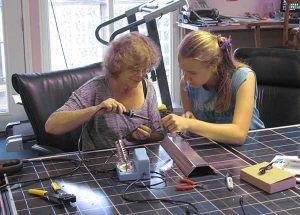Front Porch Blog

Participants in New Vision Renewable Energy’s workshops build solar panels and cooperate on other clean energy projects for use at home and abroad. Photo by Lauren Norris
For more than 15 years, Appalachian Voices has worked to protect the air, land and water of Central Appalachia. We do this work because the protection of the place we live is integral to the health, happiness and prosperity of our communities. We do this work for the benefit of all people in Central Appalachia.
Despite this, we often feel bogged down in contentious rhetoric that pits “treehuggers” against “friends of coal.” We often must spend all our time dealing with problems — water pollution, dust problems and violations of existing laws — when we’d much rather focus on collaboration and finding solutions.
As coal production continues to decline and cheaper reserves outcompete Central Appalachian coal, the need to diversify the regional economy is becoming even more critical. Several recent events demonstrate that many in Central Appalachia may be ready to take on the task.
Early this year, Kentuckians for the Commonwealth held the Appalachia’s Bright Future conference, which attracted 200 participants. In December, two additional conferences were held – “Shaping Our Appalachian Region” or the SOAR conference, which was hosted by Kentucky Governor Steve Beshear and Congressman Hal Rogers, and the Alliance for Appalachia’s Economic Transition Summit.
I arrived at the SOAR Conference, held in Pikeville, Ky., with little idea of what might happen there. The last time I had been at the Kentucky Expo Center in Pikeville for EPA hearings on valley fill permits in Kentucky, my group was accompanied out of the building by a federal agent who feared for our safety in a palpably hostile pro-coal environment. I had higher hopes for the SOAR conference, but realistic expectations.
I found myself pleasantly surprised by the SOAR conference. A crowd of more than 1,500 people attended. The morning consisted of talks by Beshear and Rogers, and entrepreneurs who had found success in Central Appalachia. The talks were positive and there was no mention of a “war on coal.” In the afternoon, participants were given ample time to provide ideas and feedback during nine breakout sessions focused on jobs, entrepreneurship, infrastructure, tourism, regional identity and other important areas, during the breakout sessions. Some common themes included the need to effectively invest coal severance taxes back into coal-impacted communities, and the need to support education and communities in ways that encourage youth to remain in the region.
Though the conference went well – only a few state politicians toward the end of the conference advocated for “clean coal” and a continued reliance on a strictly coal economy – the ideas expressed were only ideas. We have yet to come up with actions based on these ideas that will help a place that is struggling right now. Though many are currently working on economic diversification – including Kentuckians for the Commonwealth, Mountain Association for Community Economic Development, and Appalachian Voices – it is difficult not to be impatient when so much more needs to be done.
Following the conference, the SOAR committee promised to compile and report the recommendations from the conference to Beshear and Rogers within 30 days. Beshear and Rogers will produce a plan within another 30 days. I am intrigued and cautiously optimistic about the final plan.
As a fitting follow-up, I attended the Alliance for Appalachia’s Economic Transition Summit the following weekend. While many Alliance meetings include only members of Alliance organizations, this summit attracted many groups and individuals from outside the Alliance. While it is always great to get a chance reconnect with my allies from across the region, it was even better to meet a more diverse group of participants.
Some of the most useful discussions included how future summits might be made as inclusive as possible, and the importance of proper dialogue. With many interests in the room at any one of these events, it is important to recognize coal’s historical importance in the region, and that it will likely remain a part of the economy for quite some time. Using terms such as “economic diversification,” rather than “economic transition,” maybe not only be a more accurate representation of the current situation, but may also help to make the dialogue more inclusive.
Most importantly, we need to determine how to turn ideas into actions. Though this conversation has been a long time coming, the inclusive dialogue seems to be relatively new. The inclusive dialogue is the integral part that many efforts in Central Appalachia have been missing. Despite the best efforts of many, the climate may not have been ripe for the type of collaboration emerging now. My hope moving forward is that all of those who have attended these conferences, and anyone who would like to be attend future events, are able to sustain their motivation during a process that will likely take many years to complete.
PREVIOUS
NEXT
Related News

Leave a comment
Your email address will not be published. Required fields are marked *
